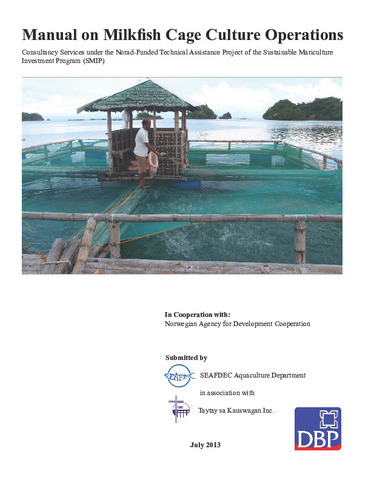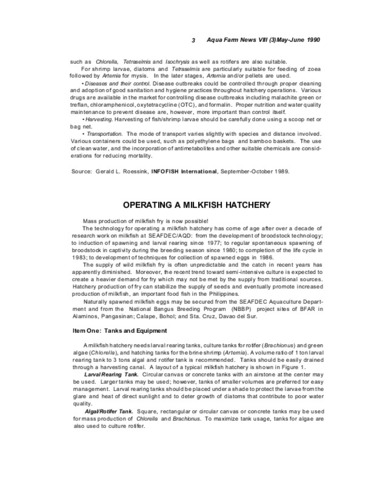Commercial pelleted milkfish (Chanos chanos Forsskal) feeds: Physical characteristics and nutrient contribution to water quality in milkfish farming
| dc.contributor.author | Lantin-Olaguer, Imelda | |
| dc.date.accessioned | 2024-11-27T02:17:59Z | |
| dc.date.available | 2024-11-27T02:17:59Z | |
| dc.date.issued | 2006 | |
| dc.identifier.citation | Lantin-Olaguer, I. (2006). Commercial pelleted milkfish (Chanos chanos Forsskal) feeds: Physical characteristics and nutrient contribution to water quality in milkfish farming. Faculty Research Journal, 1(2), 22-41. | en |
| dc.identifier.issn | 2094-2206 | |
| dc.identifier.uri | http://hdl.handle.net/10862/6571 | |
| dc.description.abstract | In milkfish farming, when food wastage is high and assimilation is poor, most of the nutrients added to the culture species may ultimately pollute the environment. Assessment of water dispersion from ponds and cages rarely take into account the physical properties of feeds. This study dealt with settling velocity, physical stability, and the amount of nutrients (nitrogen and phosphorus) generated by milkfish feeds alone in water. Four locally manufactured milkfish (Chanos chanos) pelleted feeds labeled as: Grower A, Grower B, Grower C, and Finisher D were tested, with freshwater, brackishwater and seawater as test media. Settling velocities of the four feeds were generally greater in freshwater than in brackishwater and in seawater, ranging from 11.0-11.5 cm s-1 for 6-8. mm long pellets, and 12.8.0-13.0 cm s-1 for 9-11 mm pellets with Milkfish Finisher D. In brackishwater, settling velocities of size ranges 6-8 and 9-11 mm long were 9.8-10.0 and 11.0-11.6 cm s-1 respectively. In seawater, settling rates of milkfish feeds were 8.0-8.5 and 9.8-10.1 cm s-1, for the same size ranges. There was no significant difference on the settling velocities among feed brands tested but significantly different within water types (P> 0.05). Water stability of these pellets was tested within 15, 30, 60 and 120 minutes immersion time. The four-feeds tested showed a range of water stability of 84.4-87% for the first 15 min in seawater, 70-82 % in brackishwater and 74-82% in freshwater. They are not that water stable after one hour with water stability of 35-40%. Nutrient contribution assessment of these feeds was also carried out by submersion test. Total ammonia nitrogen (TAN) concentrations in freshwater generated by the four feeds were low and were not that significant during the first two days. Values abruptly rose above the initial concentrations of 0.04 to 3.25-6.97 mg l-1 on the6th day of submersion. In freshwater, Grower A had the highest TAN concentration value of 6.97 mg l-1 and Grower D had the lowest value of 0.1 mg l-1. Nitrite concentration was low at a range of 0.01-0.04 mg l-1 while nitrate ranged from 0.1-0.76 mg l-1 for all the feeds. In brackishwater, TAN concentrations steadily rose to a range of 2.5-3.5 mg l-1 in all feeds, while in seawater a lower concentration than the brackishwater of 0-1.2 mg l-1 within 7 days of submersion was obtained. Phosphate-P concentrations rose on the second day of submersion in all test media and abruptly fell on the fifth day. Grower B gave the highest phosphate concentration of 1.55 mg l-1 in freshwater and 1.44 mg l-1 in brackishwater by the same feed and 2.0 mg l-1 by Grower A in seawater. ANOVA showed no significant differences among the feeds in terms of N and P concentrations obtained within seven days of submersion (P< 0.05). Nutrient inputs from feed undergo nutrient transformation and nutrient buildup was very apparent especially in freshwater and in brackishwater. The results of this study are measures of the significance of physical properties and nutrient releases of commercial feeds on the water quality of milkfish culture system. Data gathered can be applied into feeding management techniques, selection of good quality feeds and can be incorporated into models defining the impact of pollution from commercial feeds on the environment. | en |
| dc.language.iso | en | en |
| dc.publisher | University Research Office, St. Paul University Iloilo | en |
| dc.subject.lcsh | Pelleted feed | en |
| dc.title | Commercial pelleted milkfish (Chanos chanos Forsskal) feeds: Physical characteristics and nutrient contribution to water quality in milkfish farming | en |
| dc.type | Article | en |
| dc.citation.volume | 1 | en |
| dc.citation.issue | 2 | en |
| dc.citation.spage | 22 | en |
| dc.citation.epage | 41 | en |
| dc.citation.journalTitle | Faculty Research Journal | en |
| dc.subject.asfa | milkfish culture | en |
| dc.subject.asfa | feeds | en |
| dc.subject.asfa | nutrients | en |
| dc.subject.asfa | water quality | en |
| dc.subject.asfa | nitrogen | en |
| dc.subject.asfa | phosphorus | en |
| dc.subject.asfa | ammonia | en |
| local.subject | commercial feeds | en |
| local.subject | settling velocity | en |
| local.subject | water stability | en |
| local.subject | nitrogen | en |
| local.subject | phosphorus | en |
| local.subject | ammonia | en |
Files in this item
| Files | Size | Format | View |
|---|---|---|---|
|
There are no files associated with this item. |
|||
This item appears in the following Collection(s)
-
Journal Articles [1247]
These papers were contributed by Department staff to various national and international journals.



